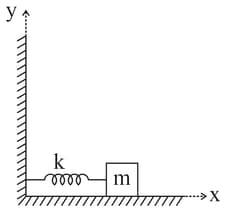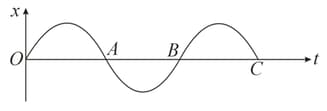MEDIUM
Earn 100
Which of the following is correct about Simple Harmonic Motion (SHM) along a straight line?
(a)Ratio of acceleration to velocity is constant.
(b)Ratio of acceleration to potential energy is constant.
(c)Ratio of acceleration to displacement from the mean position is constant.
(d)Ratio of acceleration to kinetic energy is constant.
(e)Ratio of acceleration to angular frequency is constant.
50% studentsanswered this correctly
Important Questions on Simple Harmonic Motion
EASY
An object of mass is attached to a spring which is fixed at one end on a rigid support and the mass-spring system is kept on a frictionless table. The object is allowed to execute simple harmonic motion along - direction. The force constant of the spring is and the spring is stretched initially a distance of , the total energy stored in the system is

EASY
EASY
HARD
EASY
A body of mass is executing simple harmonic motion. Its displacement at seconds is given by . Its maximum kinetic energy is
HARD
EASY
Total energy of a particle performing S.H.M. is NOT proportional to
MEDIUM
(a) Potential energy is always equal to its
(b) Average potential and kinetic energy over any given time interval are always equal.
(c) Sum of the kinetic and potential energy at any point of time is constant.
(d) Average in one time period is equal to average potential energy in one time period.
Choose the most appropriate option from the options given below :
HARD
EASY
HARD
EASY
MEDIUM
MEDIUM
EASY
EASY
The variation of displacement with time of a particle executing free simple harmonic motion is shown in the figure.

The potential energy versus time plot of the particle is correctly shown in figure:
MEDIUM
MEDIUM
MEDIUM
MEDIUM

